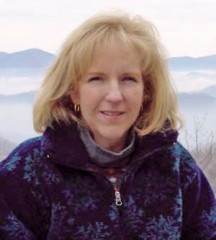
Carol Branton Morrow spent her childhood in Winston-Salem, where her parents took every opportunity to instill in her their love of nature. This affair with nature has continued throughout her life and led her to live in the Asheville area. After a career in advertising, Carol picked up where she left off in college and is once again pursuing her love of painting. Carol’s painting, “One More Berry Please” is shown on this month’s (March 2012) cover.
Rapid River Magazine: How long have you been an artist?
Carol Branton Morrow: I have been an artist all of my life. In my youth I always carried a sketch book to record objects or write down descriptions of things that inspired me. My college career started as a fine arts major, but ended up in the field of graphic design. After a 28-year career in that field, I finally have the opportunity to return to my first love – painting.
RRM: How many hours a day do you create?
CBM: I devote at least four or five hours a day to my creative side. I am still freelancing for advertising clients, and that affects my schedule.
RRM: You use different mediums. How do you decide what medium you’re going to use? Do different subjects call you to use different mediums?
CBM: I usually choose the medium that best suits my emotional reaction to a subject. I paint in watercolor, oil and pastel. My primary medium is pastel, but it’s unusual for my paintings to be pure pastel. Most often, I use watercolor or oil stain as an underpainting, adding layers of pastel on top.
I like my oil stains to have runs, and if I’m lucky the under-stain will provide “spider-webbing” in just the right places to enhance a field of grass or a stand of trees. Watercolor can be as spontaneous as oil, but in different ways. There still will be runs, but there also can be “blooms” that inspire and move the painting forward. At times, I apply the pastel sparingly to let the underpainting speak. Other times, the underpainting virtually disappears.

RRM: Why have you chosen mostly to work with pastel and watercolor as your media?
CBM: Pastel is such a spontaneous medium. You don’t “mix” your paints like you do in wet mediums. I see that spot of beautiful purple in the shade, then look at a box of pure color until I find the pastel that says “put me there.” Of course, I can mix pastels together by layering or blending, but the initial emotional reaction to color and light is right at your fingertips.
Ask pastel artists how they feel when they open up a new box of pastels and you’ll see that we’re like kids in a candy store. The pure color just makes you want to express yourself.
RRM: How would you describe your painting style?
CBM: I am an impressionist. I don’t want to produce an exact replica of what I see. I want the viewer to feel the emotion of my first “Wow, how beautiful” moment. It’s all about color and light and how these elements mix and play off one another.
RRM: Can you tell me a little bit about your painting process?
CBM: The first thing I do before starting a painting is to sit quietly and absorb my subject. I have to have an emotional reaction to the subject for me to feel as if my painting will be successful. I sketch out the subject in different formats – horizontal, vertical and square. I look at the sketches and decide if something needs to be taken out or moved to create a more pleasing composition.
When I move to my paper, I barely sketch in the outlines of the subject, not as individual objects but as shapes of masses. I am not seeing a tree or house, but at this point, just shapes. I then lay in the shapes with my wet medium, starting with the shadows and dark objects. The underpainting IS NOT a finished painting. It is almost abstract, and sometimes actually is. I paint with the paper on a vertical surface. This allows the pigment to freely run down the paper, creating interest as it goes. Of course, you have to pick and choose which runs are acceptable, wiping out the unwanted ones, or you’ll end up with a mess.

After my underpainting has dried, I move to pastel. Just as in the initial painting, I lay in my darks first. Although it’s quite tempting to put detail in at this point, I try to refrain from doing that. I lay in my masses and gradually get more detailed. The highlights are the very last thing I do, and this is the part I love the most. After I have worked and worked to make the painting a success, the highlights are the icing on the cake!
RRM: What was your progression as an artist? Did you start with pastels and then move to watercolor? How did that progression happen?
CBM: My mother was a watercolor artist, so naturally I began there. It was not until late 2009 that I decided to get serious about pastel. Now that I mix the two mediums, I get the best of both worlds – the flow of wet pigment and the spontaneous application of pure pigment on the same painting surface. It can be glorious!
Carol Branton Morrow’s work is on display at Studio B in North Asheville.
Studio B, 171 Weaverville Highway, Asheville
(828) 225-5200, www.galleryatstudiob.com
Carol Branton Morrow’s web site: www.carolmorrowstudio.com

Comments are closed, but trackbacks and pingbacks are open.